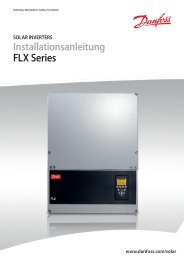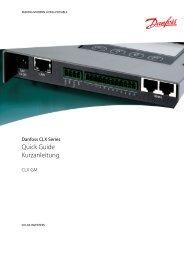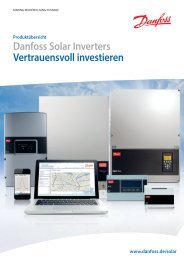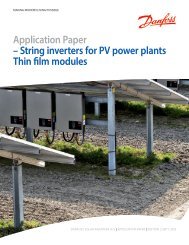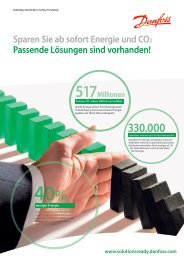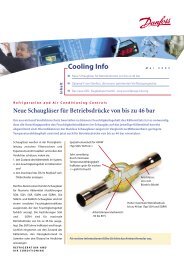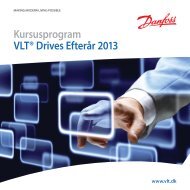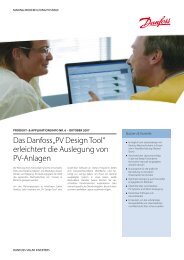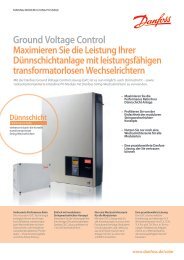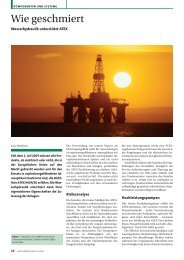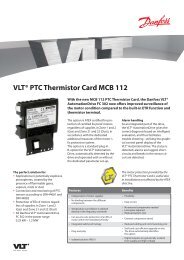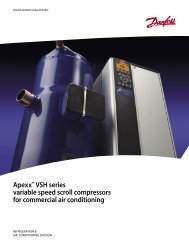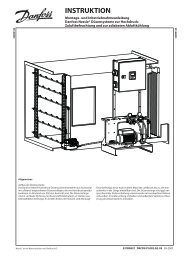Options for Electric Power Steering Modules a Reliability ... - Danfoss
Options for Electric Power Steering Modules a Reliability ... - Danfoss
Options for Electric Power Steering Modules a Reliability ... - Danfoss
You also want an ePaper? Increase the reach of your titles
YUMPU automatically turns print PDFs into web optimized ePapers that Google loves.
� Additional com<strong>for</strong>t / safety features like superimposed<br />
steering and rear wheel steering will require<br />
high-power electric actuation<br />
A fundamental scope is on finding the right trade-off<br />
between cost, per<strong>for</strong>mance and the imperative reliability.<br />
Globally, about 10 major steering system suppliers<br />
of are working on electric power steering. They rely<br />
on a couple of experienced partners specializing in<br />
customized electronic components.<br />
2. <strong>Power</strong> Electronic Requirements<br />
The design of an electronic control (ECU) unit <strong>for</strong><br />
power steering systems starts with a careful description<br />
of the mission profile and environment of operation.<br />
The fundamental difference between a direct drive<br />
EPS and a pump-operated EHPS is, that true servo<br />
application EPS puts a higher current- and temperature-cycling<br />
profile on the power stage of its control<br />
unit.<br />
In contrast, an electro-hydraulic unit usually operates<br />
on continuously low revs to sustain a specific system<br />
pressure. In case of high demand <strong>for</strong> steering aid,<br />
the pump powers up to provide maximum output.<br />
Typically, the maximum load is described by an outstanding<br />
test scenario, e.g. a parking lot test with<br />
repetitive high steering demand under concurrent<br />
high ambient temperature load.<br />
1<br />
4<br />
6<br />
2<br />
5<br />
3<br />
1. Bondable frame<br />
2. DC connection<br />
3. Capacitor,<br />
EMC Filter<br />
4. AC-Motor<br />
connection<br />
5. Integrated<br />
power module<br />
6. Control board<br />
Figure 1: Example of an ECU (Electronic Control<br />
Unit) <strong>for</strong> <strong>Electric</strong> <strong>Power</strong> <strong>Steering</strong><br />
The designer of an ECU must blend these external<br />
requirements with space and cost constraints in the<br />
control unit. To survive the described harsh test and<br />
operating conditions, a proper thermal management<br />
of the device is highly relevant.<br />
In the past often one single type of circuit carrier,<br />
e.g. glass-epoxy (FR4) or thickfilm-ceramics were<br />
sufficient to arrange the whole componentry of an<br />
ECU. Since currents are increasing substantially,<br />
specialized substrates <strong>for</strong> signal and power stage<br />
are moving into modern ECUs.<br />
Dedicated power modules allow to increase power<br />
density and can dissipate up to 10 W / cm². Alongside,<br />
they can be designed to take the strong thermal<br />
cycling loads coming <strong>for</strong> the extensive servo<br />
operation.<br />
3. Solution Overview <strong>Power</strong> <strong>Modules</strong><br />
3.1 Bare DBC Substrates<br />
The most simplistic PWM-power-stage can be demonstrated<br />
by a populated DBC-substrate. These<br />
substrates typically comprise a MOSFET six-pack to<br />
drive a three phase motor. MOSFETs are typically<br />
soldered with a virtually void-free alloy, that gives<br />
sufficient headroom between maximum operating<br />
temperature and the solder melting temperature.<br />
Figure 2: Bare DBC-Substrate with MOSFET-<br />
Transistors <strong>for</strong> glue-on-assembly<br />
The proven Al2O3-Substrates with a thermal expansion<br />
coefficient of 7-8 ppm/k are matching well with a<br />
silicon die of about 3 ppm/k.<br />
Ceramic substrates provide excellent isolation up to<br />
several thousand volts and are good heat conductors.<br />
The thick and homogenous Cu-coating on the<br />
DBC’s front and backside provides a good temperature<br />
distribution, lateral spreading and very low ohmic<br />
losses.<br />
Compared to usual 100 µm thickfilm-copper-glaspaste<br />
hybrids the electrical conductivity of a DBC is<br />
about 6 times higher.<br />
Automotive <strong>Power</strong> Electronics – 26-27 September 2007 – Paris Page 2/9



